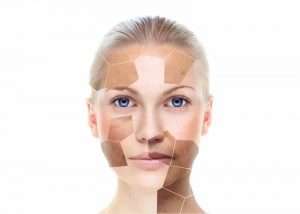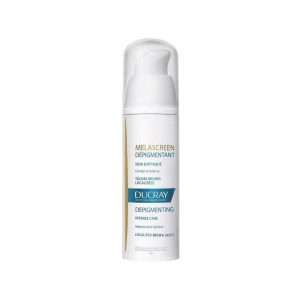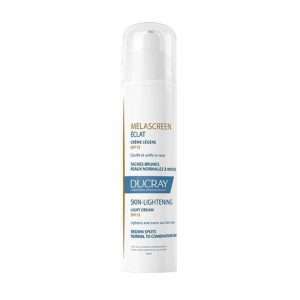
Sunspots, pimple marks, melasma spots: In all its forms, hyperpigmentation can be as inevitable as the forces that fuel it – the sun, the heat, and your hormones. Hyperpigmentation must be one of the most difficult problems to solve on your own. That’s why we are here to help. If you are bothered by spots of any kind, check out this article from The Dermo Lab in collaboration with the dermatologist and cosmetologist Dr. Dany Tawileh. Keep reading to learn more about the different pigmentation treatment options!
Is skin pigmentation normal?
According to Dr. Dany Tawileh, skin pigmentation is not normal and is one of the biggest and hardest problems for both the patient and the physician.
Pigmentation, or hyperpigmentation, is the darkening of the skin in localized patches or sometimes in extensive areas in the case of generalized hyperpigmentation. Hormonal fluctuations, sun exposure, inflammation, aging, and certain medications can lead to an overproduction of melanin (pigment) by the melanocytes (pigment-producing cells).
What are the different types of pigmentation?
It turns out that not all dark spots are the same. In fact, before you even think about pigmentation treatment, you need to know what type of discoloration you’re dealing with.
- Sunspots and Freckles
Sunspots and age freckles are types of pigmentation caused by chronic sun exposure and aging. They usually appear on the back of the hands and the face.
- Melasma
Melasma is a brownish discoloration with spots on the forehead, cheeks, and upper lip area. It results from hormonal factors such as the oral contraceptive pill, pregnancy, genetics, and sun exposure.
- Post-inflammatory hyperpigmentation
Post-inflammatory hyperpigmentation is more of a reactive increase in pigmentation due to inflammation, such as acne, or superficial trauma (such as scratching pimples).
- Drug-induced pigmentation
Certain medications such as antimalarials and some antibiotics can cause pigmentation.
- Generalized pigmentation
Generalized pigmentation can be caused by dermatological conditions such as lichen planus or underlying medical conditions such as Addison’s disease.
What is the best treatment for pigmentation on the face?
To treat facial pigmentation, you should include products in your routine that are proven to reduce brown spots and even out your skin tone.
To improve the appearance of pigmentation, Dr. Dany Tawileh explains that the patient should avoid the sun (UVA and UVB) and use sunscreen. He/she can also use medications that can decrease melanin production. Another way is the use of skin lightening creams and serums.
1- Sunscreen
Sun protection is the most important step you should take to prevent hyperpigmentation in the first place. It’s important to keep in mind that the sun’s rays affect the skin even on cloudy days, so give your skin the daily protection it needs regardless of the weather. Dr. Dany Tawileh notes that using sunscreen does not help remove dark spots, but it does help prevent them and reduce their severity.
Sun exposure is one of the most controllable factors. Patients with hyperpigmentation should avoid direct exposure to the sun. Try to stay out of the sun during its most intense hours and wear protective clothing, including hats and sunglasses, whenever possible. When skin is exposed to the sun, apply and reapply sunscreen regularly.
Sunscreen is an absolute necessity! Look for a broad-spectrum sunscreen that blocks both UVA and UVB rays, with an SPF of 30 or higher.
We would like to share with you our top favorite sunscreens to protect you from UV rays.
Ducray Melascreen UV Light Cream SPF50+: which also reduces the existing brown spots.
Eau Thermale Avène Very High Protection Fluid SPF 50+
2- Depigmenting creams
Depigmenting creams are designed to lighten the color of the skin. They act by reducing the amount of melanin. These creams can be used on the entire face to lighten the complexion or treat certain skin areas, such as age spots or acne scars. They are enriched with depigmenting active ingredients such as hydroquinone, vitamin C, niacinamide, and azelaic acid.
If you are concerned about hyperpigmentation, look for skin care products that have been formulated to address this problem and have been clinically and dermatologically proven effective. For your convenience, we recommend the following Ducray products that will correct and reduce localized hyperpigmentation. They’re generally applied once or twice a day to help lighten and even out your skin tone.
Ducray Melascreen Depigmenting Intensive Care: applied on the localized brown spots.
Ducray Melascreen Eclat Light Cream SPF15: applied on the entire face to even out the skin tone.
3- Laser treatments
Laser treatment uses targeted light beams to reduce hyperpigmentation.
Two types of lasers are available: ablative and non-ablative. Ablative lasers are the most powerful and involve removing layers of your skin. On the other hand, non-ablative procedures target the dermis to promote collagen growth and tightening effects. Both destroy elements of your skin so that new skin cells grow back tighter and more toned.
Dr. Dany Tawileh indicates that laser treatment for pigmentation of the face can have side effects when working on large areas. These include redness, swelling, itching, infections, changes in skin color, and even scarring. In smaller areas, such side effects are rare.
4- Chemical peels
A chemical peel uses high levels of acids to treat the desired area of skin. They reduce the appearance of hyperpigmentation by removing the epidermis. Deeper versions can also reach into the middle layer of your skin to produce more significant results.
Dr. Dany Tawileh states that peelings with acids can be soft or deep, which depends on the acid used. Peeling sessions using azelaic acid and glycolic acid are proven to be effective for superficial pigmentation. In the case of deeper pigmentation, trichloroacetic acid (TCA) or a high concentration of other acids is used.
What is the treatment of dark pigmentation around the mouth?
Dr. Dany Tawileh affirms that pigmentation around the mouth and especially around the upper lip remains the most difficult to treat.
Good news, the products above can help treat this pesky problem. It’s important to apply sunscreen to your face and focus on the area around the mouth which can sometimes be neglected. This will protect your skin from further sun damage and hyperpigmentation. You should also apply the above-mentioned depigmenting and lightening creams around your mouth to even out your skin tone and give your skin a bright and healthy look.
Also, remember to stop licking your lips, as this habit can harm the area around your mouth or your lips.
Dr. Dany Tawileh adds that we can improve dark pigmentation around the mouth by using 2-4% hydroquinone or the ND YAG laser.













